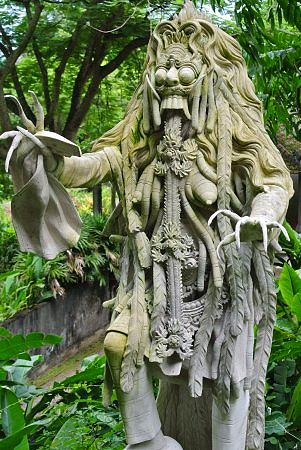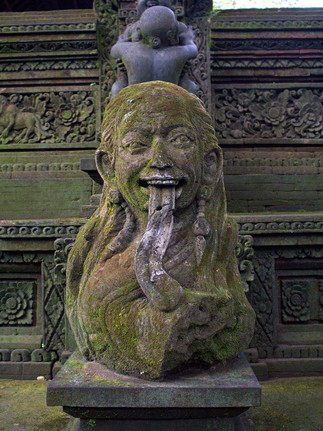Blood and Shadows - Unmasking the Leyak’s Curse
- Shannon
- Sep 19
- 4 min read
Shadows That Haunt the Night
In the shadowy heart of Balinese folklore, the Leyak (or Leak) stands as one of Bali's most feared and sinister supernatural entities, but these dark witches do not act alone. They serve under the terrifying rule of Rangda, the fearsome Queen of black magic and witchcraft, whose grotesque visage and unrelenting malevolence embody the island’s deepest fears. Unlike mere ghosts or spirits, Leyaks are said to be powerful witches or practitioners of dark sorcery, often depicted as grotesque human-like creatures with animalistic features, sharp fangs, bulging eyes and long tongues dripping with venom. By day, they blend into society as ordinary villagers but by night they transform into horrifying flying heads with entrails and organs trailing beneath, haunting the darkest corners of Bali’s rice fields and remote villages. Their existence is not mere superstition but woven into the cultural and spiritual fabric of the island, an ever present reminder of the thin line between the natural and the supernatural.
Origins of Fear - The Birth of the Leyak Legend
The origin of the Leyak is rooted deeply in ancient Balinese animism and Hindu Balinese mysticism, where magic and spiritual power permeate everyday life. Leyaks are believed to be humans who have willingly surrendered their souls to dark forces in exchange for supernatural abilities, primarily to inflict harm, spread disease or manipulate life and death. This pact grants them powers such as shape shifting, invisibility and control over malevolent spirits. The transformation into a Leyak often involves a nightmarish ritual, where the witch detaches their head from the body, flying with it to stalk victims under the cover of darkness. The trailing organs, grotesquely visible, symbolise the severing of their humanity and the embrace of evil.

An Army of Nightmares
Leyaks are particularly feared for their ability to suck the life essence or blood from pregnant women and newborn babies, causing illness or death. This sinister aspect makes them central figures in Balinese explanations for sudden infant mortality or miscarriages. In remote villages, new mothers are often guarded vigilantly against these nocturnal predators. Stories abound of villagers spotting a floating head with fiery eyes swooping through the night, accompanied by the nauseating stench of decay. The presence of a Leyak is not just physical but spiritual, believed to bring curses, plagues and widespread misfortune upon entire families or communities. Their victims rarely survive and the tragedy is attributed to the malevolent influence of these witches.

Guardians of Balance
The Leyak’s power is countered only by strong spiritual forces and ritualistic purification performed by Balinese priests or Balian. These shamans use holy water, mantras and protective amulets to repel Leyaks and their curses. However, the battle between Leyak and Balian is more than physical, it is a war for souls and the balance between good and evil within the village. The fear of Leyaks reinforces the strict social and moral codes in Balinese society, where accusations of witchcraft can be deadly, often leading to violent ostracism or ritual expulsion. The Leyak thus serves as a social control mechanism, a dark embodiment of the collective anxieties over death, illness and the unknown forces lurking beyond human understanding.
The Curse That Walks With Us
What makes the Leyak especially chilling is the paradox of its proximity to normal life. These entities are not distant mythic monsters but are imagined to walk among the living, indistinguishable by day from the innocent neighbour, friend or family member. This duality, human by sunlight, monster by moonlight, creates a pervasive sense of paranoia and distrust in the rural communities of Bali. In some villages, elderly people still recount whispered tales of spotting Leyak heads in flight or waking to find the gruesome aftermath of their visitations. The Leyak legend persists not merely because of ancient belief but as a living shadow haunting modern Balinese identity, blending spirituality, fear, and cultural memory.

Spiritual Battles in a Changing World
In the contemporary context, while many Balinese treat the Leyak as folklore, the legend continues to exert a powerful psychological hold, influencing social dynamics and spiritual practices. Modern media, tourism and popular culture have sensationalised the Leyak, yet for many Balinese, the line between myth and reality remains blurred. In remote corners, the fear of Leyak still dictates nighttime behaviours, doors are locked, protective talismans are worn and rituals are performed to guard against the darkness. The Leyak is a dark emblem of Bali’s unseen spiritual battles, a chilling reminder of the island’s mystical past, where magic and malevolence walk hand in hand beneath the tropical moonlight.
Sisters of the Night
Across Southeast Asia and beyond, many cultures share chilling legends of flying female entities like Bali’s Leyak. Similar creatures appear as the Penanggalan in Malaysia, the Krasue in Thailand, the Manananggal in the Philippines and the Nukekubi in Japan. These spirits often originate from women who died unjustly or practiced black magic and they prey on the living, especially pregnant women or the sick. What’s most unsettling is that despite regional differences, witnesses across generations and countries consistently describe seeing nearly identical figures, suggesting either a deep cultural archetype or something far more real lurking in the night.

Thanks for reading Blood and Shadows - Unmasking the Leyak’s Curse. Check out more fascinating legends and awesome destinations here!

































